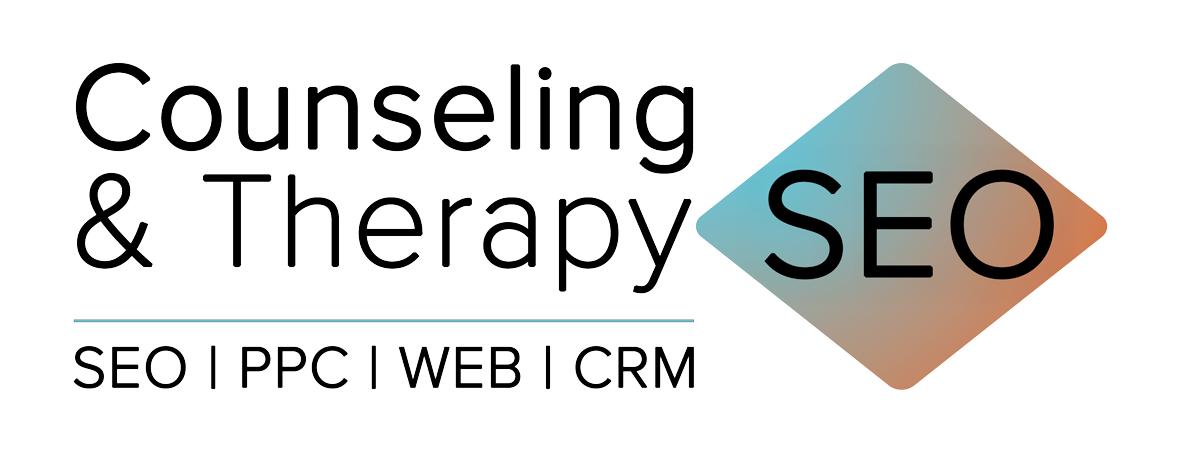The Big Question Therapists Ask
“How much should I spend on marketing?”
It’s the question almost every owner asks once growth stalls or the calendar feels unpredictable.
Most fall into one of two traps. Some spend nothing, hoping referrals and Psychology Today listings will be enough. Others overspend blindly, throwing money at ads or directories without a system. Both approaches waste time, money, and energy.
And that’s the real frustration, isn’t it? You’re not afraid to invest.
You just don’t know what’s actually worth investing in.
The truth is, your marketing budget should never come from guesswork. It should be tied directly to your growth goals. Once you understand the benchmarks, the answer becomes pretty clear.
Why Marketing Budgets Matter in Counseling
You as a Therapist do not sell products. You sell your time.
Every missed lead is not just a missed opportunity, it is a block of billable hours that disappears.
At the same time, getting seen is harder than ever. Directories like Psychology Today and Zencare dominate search results. Google and Meta can limit how you can advertise. Without an intentional strategy, your practice is buried, and you end up competing on someone else’s terms or just plain invisible on the internet.
This is why marketing is not optional.
It is the system that keeps your calendar full, your pipeline predictable, and your practice stable.
The good news is there are clear benchmarks that show exactly how much a counseling practice should set aside for marketing.
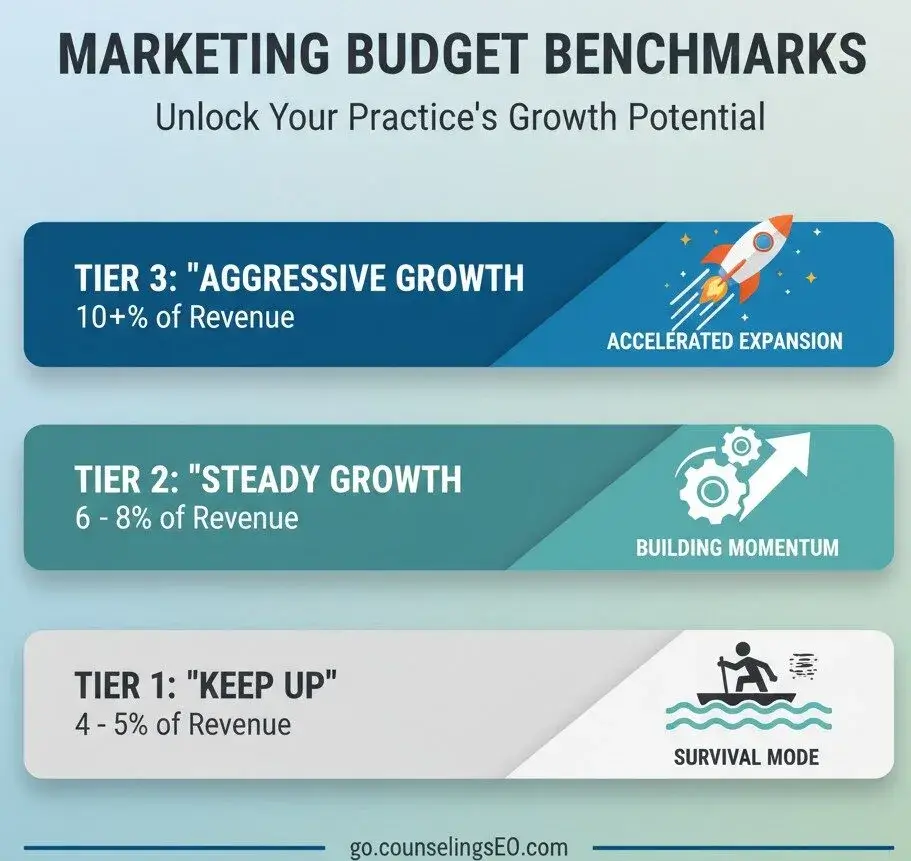
The Benchmarks (Revenue % Guidelines)
So how much should a counseling practice actually spend on marketing?
The answer depends on your goals. Industry research and practice benchmarks show that most clinics fall into one of three spending tiers. Each comes with very different results.
Here’s what the first budget tier looks like:
Tier 1: “Keep Up” (4–5% of revenue)
This is the survival tier.
At 4–5% you can cover the basics: a Psychology Today listing, a simple website, and the occasional update and maybe some light ads.
It keeps you visible, but just barely. You are relying on referrals and luck more than strategy. That might feel safe, but here is the hidden cost: it maintains your current position without creating predictable growth.
And here’s the truth most practice owners overlook: holding steady takes just as much effort as growing. So if you are already spending the energy, why not spend it on moving forward?
If your goal is simply to tread water, this level will work. But if you want a practice that grows without constant stress, it will not.
Tier 2: “Steady Growth” (6–8% of revenue)
If your goal is to add new clients consistently, Tier 2 is where most successful practices land.
At 6–8% you finally have the resources to build a foundation that works for you instead of against you:
- A professional website that builds trust and converts visitors into clients
- Local SEO that gets you found when people search “therapist near me”
- Service/modality/condition pages that match how clients actually search for help
- A steady stream of content that builds authority and keeps you visible
- Paid media to capture demand and accelerate results while SEO compounds
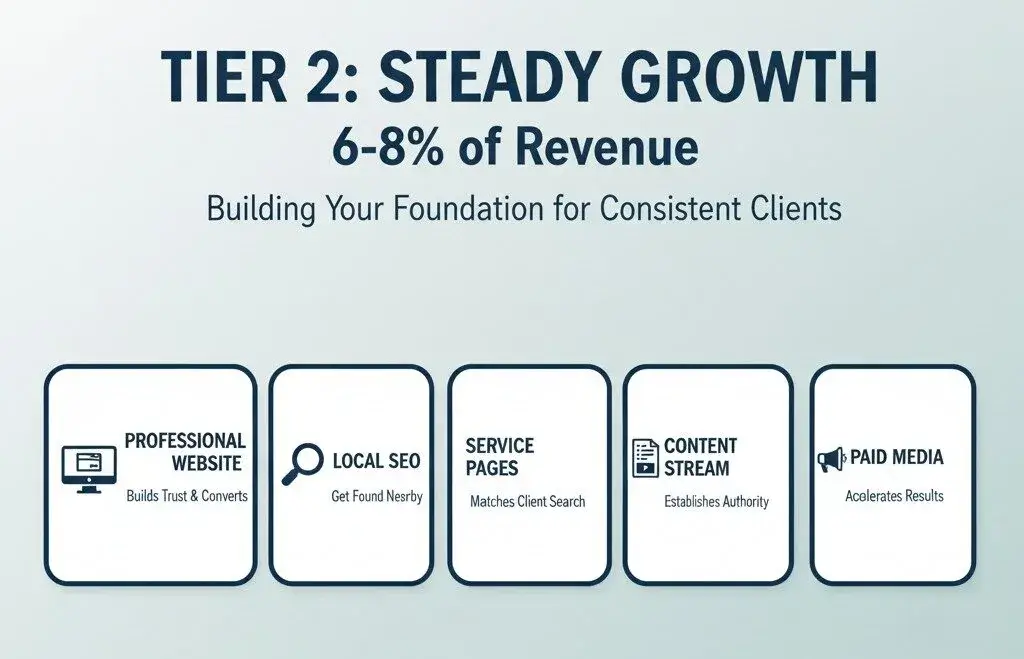
This is not just marketing fluff.
These are proven systems that make your client flow predictable. Instead of hoping the phone rings, you create a machine that steadily fills your calendar month after month.
For most group practices, this is the sweet spot. You are no longer gambling on referrals or running on luck. You are building momentum that compounds into sustainable, long-term growth.
Tier 3: “Aggressive Growth” (10%+ of revenue)
This tier is for practice owners who want more than steady growth.
It is for those ready to accelerate and scale.
At 10% or more of revenue, you are no longer just covering the basics. You are building a growth engine designed to expand your footprint and your mission. This is the level where you stop chasing clients and start shaping the market itself.
Your budget unlocks heavier paid advertising and advanced targeting that keep your clinic front and center. It funds deeper SEO campaigns that push past directories and secure long-term dominance. It gives you the ability to invest in tools like a HIPAA-compliant CRM so every inquiry is captured, followed up, and converted without leaks. And it fuels authority-building content that establishes your clinic as the trusted leader. (blogs, videos, workshops, and community engagement)
This is the level where growth stops being incremental and starts being exponential.
It is the budget for adding clinicians, opening new offices, or carving out a niche where you are the go-to specialist in your city or specialty.
But more than tactics, the mindset shifts.
You are no longer just a clinician who happens to run a practice.
You are a business builder shaping a legacy. With the right strategy, this is where you transform from keeping up with demand to owning the demand in your market.
When owners hear “10% of revenue for marketing,” it can sound intimidating. But the thing is, marketing for therapy practices is one of the highest-ROI investments in any industry.
The math makes the risk far smaller than most practice owners assume.
Putting Dollars Into Perspective (CLV vs CAC)
So what do the numbers really look like when you invest in marketing?
The average therapy client attends about 13 sessions in their lifetime. Yes, some only come three times, while others may book 30 sessions.
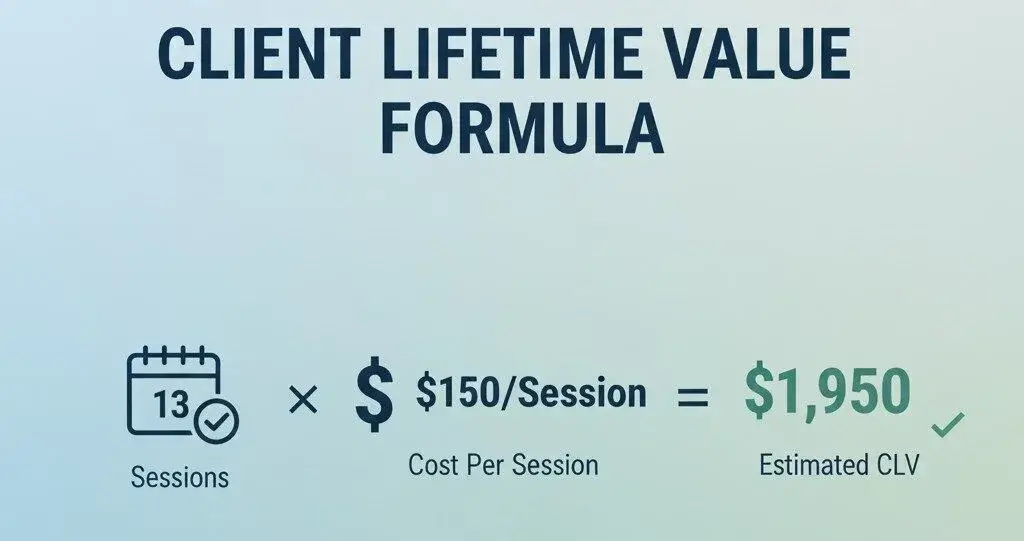
If you want to figure out your own average, use this simple formula:
(Total Number of Bookings) ÷ (Total Number of Unique Clients)
At $150 per session, that means a single new client that attends 13 sessions is worth about $1,950. And in many practices, clients stay longer than a year, which makes the lifetime value even higher.
On the other side of the equation is client acquisition cost (CAC). With search ads and consistent follow-up, most clinics spend around $100 to $250 to acquire a new client.
That works out to a 7–8:1 return. In most industries, a 3:1 ratio is considered healthy. Counseling practices routinely outperform that benchmark. Even one new client often covers your entire monthly marketing budget. Play the long game, and everything after that is profit, predictability, and peace of mind.
Common Mistakes Practices Make
Even with good intentions, many counseling practices make the same marketing mistakes. These errors quietly drain money, time, and energy while leaving the calendar as unpredictable as ever.
The three most common pitfalls we see are:
- Spending too little.
Many practices under-invest in marketing or put their limited resources into the wrong places. A Psychology Today profile or directory listing can make you visible, but it is not a growth strategy. The same goes for social media posts that rack up likes but rarely lead to booked sessions.
This is what we call “hope marketing.” You are crossing your fingers that referrals, directories, or Instagram will be enough, instead of building a system designed to bring in clients consistently.
- Spending too much without tracking ROI.
Ads without a plan are like pouring water into a leaky bucket. Leads slip through because no one answers the phone fast enough or follows up in time, and marketing dollars vanish with nothing to show for it. The bigger problem is that without tracking return on investment, you have no idea how much you are putting in and how much you are getting out.
With proper tracking in place, it is a different story. On platforms like Google Ads, you can see exactly which campaigns and keywords are working. Even better, every tracked conversion helps train Google’s algorithm. Over time, Google identifies patterns in the people who actually booked with you and starts showing your ads to more users who look like them. That means your budget gets smarter and more efficient the longer you run it.
- Relying on DIY marketing.
Writing your own blogs, tweaking your website, or dabbling in ads can feel resourceful, but it drains the hours you should be spending with clients. The opportunity cost is massive. In practice, you are paying yourself $150 an hour (or more) to do work outside your expertise. It takes you twice as long, delivers half the results, and leaves you frustrated instead of booked.
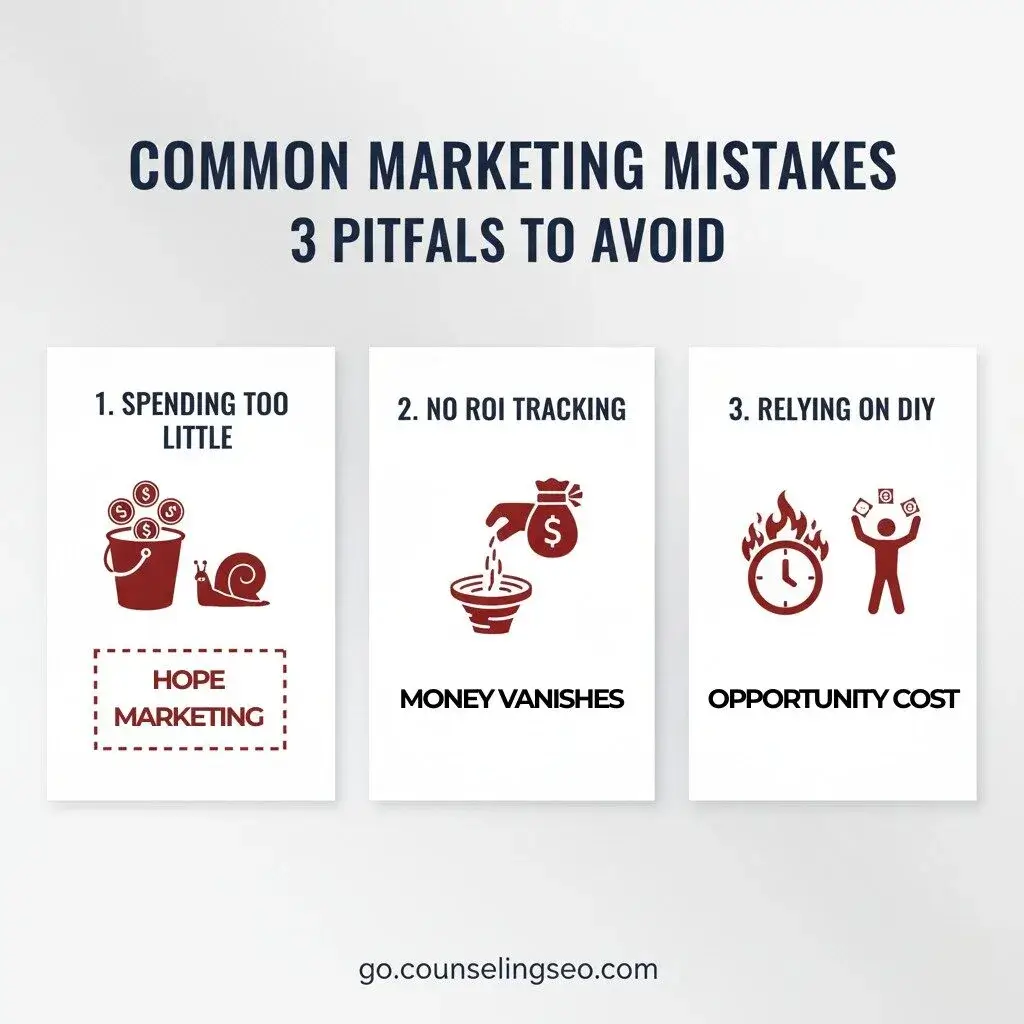
The takeaway is simple: hope marketing keeps you invisible, overspending without tracking bleeds your budget, and DIY drains the very hours that should be fueling your practice. The way out is clarity. Once you know what stage of growth you are in and what return you can expect, you can decide exactly how much to invest without guessing.
And that’s what we’ll cover next, how to set your marketing budget based on your goals and your numbers.
Stop Guessing: Here’s How to Set the Right Marketing Budget
Most practice owners ask: “How much should I spend on marketing?”
The truth is, the answer depends on your goals and your business model.
- Keep Up (4–5%): enough to stay visible, not enough to grow.
- Steady Growth (6–8%): the sweet spot for most group practices.
- Aggressive Growth (10%+): fuels new hires, second offices, and niche dominance.
Think of the percentage as a floor, not a ceiling. Marketing isn’t a sunk cost; it’s an investment that compounds over time. The real question isn’t “how much can I afford to spend?” but “how many clients do I need to cover this spend?”
Here’s where most owners get it wrong: they look at the monthly fee in isolation instead of tying it back to client lifetime value (CLV).
Take a real-world example.
- Let’s say your practice does $200,000 in annual revenue.
- At 6–8%, your monthly marketing budget should land between $1,200 and $1,600.
- In a group model, where you keep around 40% after splits, you’ll need about 4 new clients to cover that spend.
Here’s the math:
- Each new client attends about 6 sessions in their first 3 months.
- At $150 per session, your clinic keeps $60 per session after splits.
That’s $360 per client in the first 3 months. - With 4 clients, that’s $1,440 — enough to break even in Month 1, and everything after that is profit.
Scale that up:
- 6 clients = $720 in first-month revenue, $2,160 in the first 3 months.
- 15 clients = $1,800 in first-month revenue, $5,400 in the first 3 months.
The takeaway: even if you just break even in Month 1, every month after that compounds into pure margin. And if clients stay beyond three months (many do), the lifetime value quickly multiplies.
This is why smart practices don’t treat marketing as a gamble. They treat it as a growth engine that pays for itself and then keeps paying dividends.
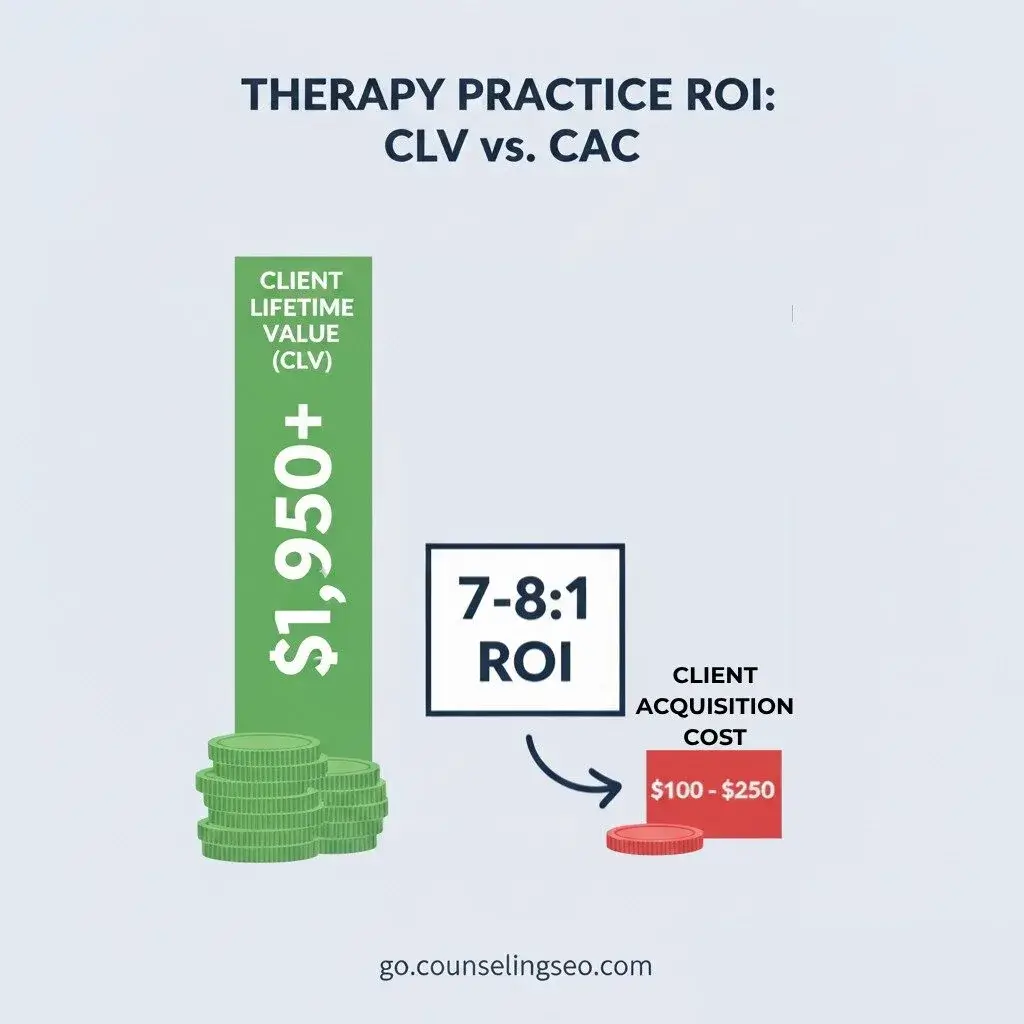
Why the Smartest Clinics Budget for Growth
Marketing isn’t overhead. It’s the growth engine of your practice.
The real risk isn’t overspending
It’s underinvesting and staying invisible.
Too many clinics treat marketing like an afterthought, something to “get to when there’s extra money.” But waiting for growth to fund your marketing is backwards. Marketing is what funds your growth.
The most successful clinics budget for marketing the same way they budget for payroll or rent. It’s a fixed, non-negotiable cost of running a healthy, predictable business. When you treat it that way, your client flow stabilizes, your team has consistency, and your stress level drops.
Every dollar invested in ethical, strategic marketing pays you back in time, freedom, and peace of mind. The clinics that plan for it don’t just fill their calendars: they scale, hire, and build lasting reputations in their communities.
The bottom line: marketing isn’t something you spend on. It’s something you build with.
Take the Guesswork Out of Growth
You don’t have to figure all this out alone.
At CounselingSEO.com, we specialize in helping therapy and counseling clinics build predictable, ethical marketing systems that actually make sense for their size and goals.
We’ll run the numbers with you—caseload, goals, and revenue—and show exactly what level of SEO or Google Ads investment fits your practice. No pressure, no jargon, just a clear path forward.
Whether you’re trying to stabilize your calendar or scale your team, this is where growth starts feeling predictable instead of risky.
👉 Book your free strategy session and see what a right-sized marketing plan could do for your practice.

Nick Man is the founder of Counseling & Therapy SEO, where he helps therapists and counselors get found on Google without compromising their values (or burning out on social media). With a background in SEO and marketing, Nick builds calm, conversion-friendly websites and SEO strategies that actually feel human.
You can find Nick on LinkedIn ↗.
